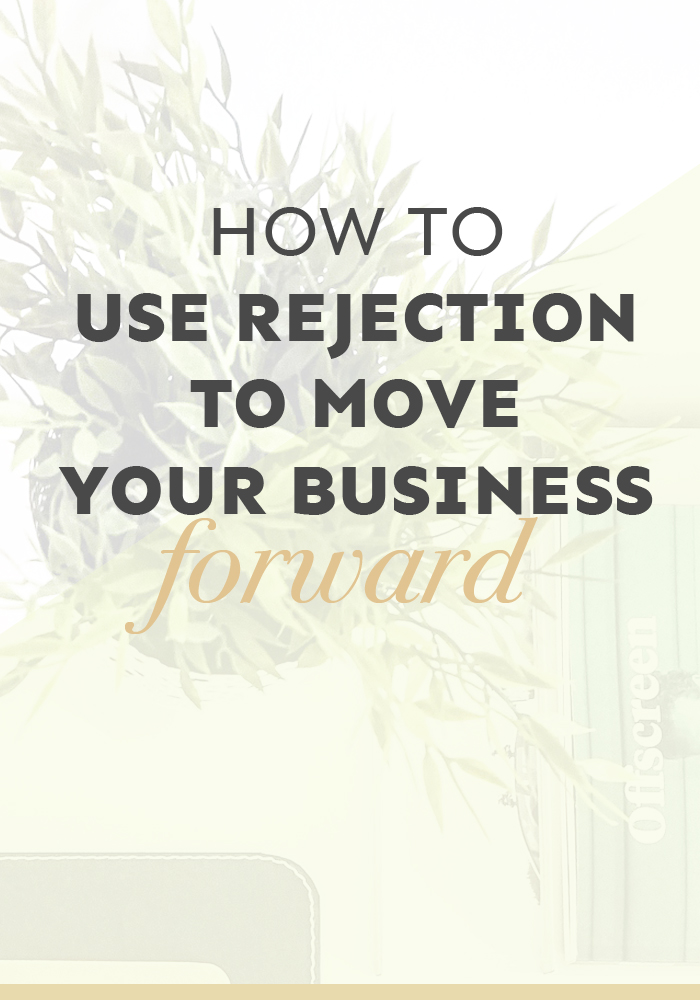Unfortunately, as freelancers, rejection is part of the package. On any given week I can receive anywhere from 1 to 20 rejections. Sometimes it’s because my prices are too high, other times it’s because there was someone better for the job.
Rejection comes in all shapes and sizes. One client might tell you it straight, while another just might not email you back. Ever. Despite you following up numerous times.
When this happens, we start questioning ourselves as freelancers and what we could have done differently.
- Should I have been more passionate about the project?
- Should I have lowered my rates?
- Did I choose the wrong samples to show them?
But let me tell you the truth. There probably wouldn’t have been ANYTHING you could have done differently. Well, bar being a completely different person.
No matter what we do, we’re always going to have to face rejection in our working life. More so than most other people, I might add. Which, on the one hand, can seem like a really sad and sorry existence, but on the other, it can be pretty liberating. Especially when you learn how to handle it appropriately and even use it to your advantage.

The one way I got over rejection
Now, most articles you read about handling rejection will simply tell you not to take it personally. That can be really damn difficult though, because we’re humans – we take EVERYTHING personally. It’s kinda what we do.
But do you want to know how I got wise to rejection? How I started welcoming it instead of fearing it (because it can be super scary, especially when you’re just starting out!)?
I separated my work from myself. I started considering my freelance work as my business, which was a completely different entity to me. I ran my business, yes, but I wasn’t my business. We were (and aren’t) the same thing.
When I started to think in this mindset, I could start distancing myself from the hurt I usually felt when I got rejected. Instead of thinking, “they hate me, I’m not good enough,” it turned into “my services or my business just weren’t right for them at this time.” And then I moved on to the next.
Trust me, it’s taken a while to get a hold on my relationship with rejection. At the beginning of my career, there were numerous occasions I just didn’t pitch for a job or I didn’t email someone back because I thought I’d get rejected.
I was too scared.
And honestly? Every freelancer goes through this thought process at one point or another, because our work is so personal to us. Because we use our creative thoughts to attract clients. And the lines between “us” and “work” can get really blurry.
So, how can you turn nasty old rejection on its head and show it who’s boss? Here are some ideas to get you started.

1. Get Feedback
I’m absolutely guilty of getting rejected from a position and then spending way too much time wondering why I didn’t get the job.
Do you know what I should have done instead of assuming and drawing up false conclusions?
Gone right ahead and asked why I didn’t get it. Nine times out of ten it’s not because you’re a terrible person who they didn’t want to work with (our brains are such wonderful things, right?!), it’s because there was a better candidate, or your experience wasn’t quite on par with what they were looking for.
When you know why something didn’t happen, you can move on and implement some changes for the next time if necessary. Start getting some more relevant experience, experiment with your pitch, and start making connections in other ways.
I admit, it can be daunting asking a potential client why they turned you down. It feels a bit desperate, right?! But employers and brands get asked this all the time. In fact, they’re probably waiting for you to ask.
When the inevitable email pops in your inbox, simply hit reply and respond with something like this:
Hi XXX,
Thank you for letting me know – I wish you every success with the project! It’d be great to know what prompted you to go with someone else. I’m always looking for ways to improve my business!
Many thanks for your time,
XXX
Simple, easy, straight to the point, and definitely not desperate. I urge you to give this a try next time you receive a rejection. You might be surprised!
2. Remember You Weren’t a Good Fit
If you hang around here often, you’ll know that I’m a big advocate of having a particular type of client you work with. Something like an ideal client. These are the people you love to connect with, that you want to (and can) help, and that make your work as dreamy as it possibly can be.
When you receive a rejection, the chances are you and this brand weren’t a good fit. Why? Because they didn’t see your value, or your potential. They couldn’t see what you could offer them.
Even if you thought you would have been the best fit on the universe, kind of like the Romeo and Juliet of the freelancing world, the chances are you had your rose-tinted glasses on (it happens!).
For the prospect, there was someone who was more aligned with their business and their goals. That doesn’t mean you’re bad at what you do. That just means you weren’t a good fit – it wasn’t you, it was them, right?!
Rejection helps you hone in on your dream clients. With every “no” you get, you’re one step closer to finding clients that are a big, fat “YES!”.

3. Act Professional at All Times
I shouldn’t really have to bring this up, but rejection brings out the worst in people. There have been plenty of times where I’ve wanted to send back a snarky email when a client turned me down “because your prices were WAY above what we expected!”, but I always force myself to take some time away from my laptop and come back with a clear head.
This is REALLY important if you want to stay credible and keep the reputation of your business in good nick.
Plus, you never know when the client might come back to you later down the line.
There was one particular brand I pitched to who I thought were fabulous. I thought we’d be the best fit on the planet. I had a phone interview and everything, but then I received the dreaded “we decided to go with someone else” email.
I was gutted to say the least.
But I thanked them for letting me know, and asked them politely why they turned me down (I thought, after all, that everything had gone swimmingly up until that stage).
They told me they’d found someone with more experience, and I thought that was the end of it.
BUT… fast forward 2 months and I get an email in my inbox from this brand. They had a position open up and they wanted me for the role. Of course I said yes, and I’m still working for them now.
Moral of the story: Be polite and professional at all times. I’m 99.9999% sure this client wouldn’t have offered me the position later down the line if I’d mouthed off at them after my rejection.
4. Keep in Touch
The world of freelancing is notoriously fickle. People change roles often, and projects fall through pretty much all the time.
Which means that nothing is forever. Just because you got rejection from a position, doesn’t mean something similar won’t open up in the future. In some cases, the freelancer they decided to hire might decide to go back to full-time work after a couple of months and leave the brand high and dry.
This is why it can be a good idea to keep in touch with dreamy brands you’d be a great fit for. Somewhere down the line a new opportunity might arise, and if you stay connected, you’ll be at the front of their mind.
What you could do: Try sending an email a month or so after your rejection to check in and see how the project’s going. Don’t be too pushy, just an email like this will suffice:
Hi XXX,
I hope you’re good!
I just wanted to check in and see that the project is running smoothly. Let me know if there’s anything I can do to help out either now or in the future.
Thanks for your time,
XXX
The important thing here is to handpick the brands you REALLY felt a connection with. Brands that are hit and miss for you aren’t worth following up with, because, well, sometimes you just need to let sleeping dogs lie, right?!

5. Know that Everyone Gets Rejected
Even the most experienced, top, top freelancers in the world get rejected. Because freelancing isn’t just about being able to provide value to your clients, it’s about being a good fit for their brand. It’s about being on the same page and creating connections with likeminded people.
Not everyone is the perfect fit for every brand, and when you start to realise that the rejections you get pave the way for exciting new opportunities, the easier it’s to handle.
Think of each rejection as a kind of stepping stone that crosses a river to your ideal client and your ideal lifestyle. They’re like checkpoints you need to reach in order to move forward, in order to define your business more, and to figure out what you actually want from your freelance business and how best you can serve your clients.
So basically, rejection is GOOD. It might not seem like it in the moment (ya’know, when your heart sinks and you feel a little bit like crying), but in the long run? In the long run it’s exactly what you and your business need.
Your turn!
How do you handle rejection as a freelancer? Are there any steps you take to turn rejection into a positive experience? Share your thoughts in the comments below!






Great tips – it’s so true that you just have to learn to use rejection as a tool rather than seeing it as a failure. I agree with keeping in touch – I’ve had a few clients who were originally rejections, so it’s worth just dropping them an email 🙂
Yes – thinking about it as a tool is definitely the way to go (especially if you’re prone to taking rejection to heart – like me!).
Great post lovely lady. We have to take all of the things that happen to us in our lives and use them for good. Keep up the great work and live unstoppable!
Rhonda Swan recently posted…Is Success in Business Optional?
Thanks, Rhonda! So true – life is all about the learning, right?! 🙂
What a great post! Thank you for all of these useful tips, I loved them. 🙂
Thanks, Jessie! I’m so glad you liked it 🙂
Just what I needed to read today. I have started doing the same thing: separating myself from my business and remembering that it’s impossible for everyone to be a good fit!
So glad it was useful for you, Lauren! Once I started doing that, rejection was SO much easier to handle!
Pinned this! So helpful for freelancers because we tend to put so much of ourselves into our work. Great points to remember. We’re not the right fit for everyone and we are not our business.
Thanks for pinning, Lori! So true, we’re not the right fit for everyone – which is a good thing!
What a fantastic and well thought out post! Especially loved the ‘Know that everyone gets rejected part’, some people take it so personally, when it’s just a part of life. Just pinned it.
Thanks so much, Naomi! Yes, it certainly helps when we realise we’re not alone in getting constantly rejected!
Keeping in touch is always so hard for me. I am working hard to remember that just because I have not spoken to a client or colleague in a long time it doesn’t mean that anything negative happened. I’m striving to rekindle old connections as I bring my business to the next level.
Great post!
Yes, I love that thinking, Marisa! Keeping in touch is difficult, especially when you move on, land new clients, and get really busy with work. It only takes a moment to check in with someone, though, so it might be worth setting aside an hour each month to just drop an email to past clients.
What a fabulous post AND outlook! I love the concept of learning from rejection (and not stressing over it). I can totally relate to the temptation to send a snarky response. But it’s never worth it. Even if someone was being a jerk (they usually aren’t!) Displaying a bad attitude says way more about you than it does them. Take the high road, always 🙂